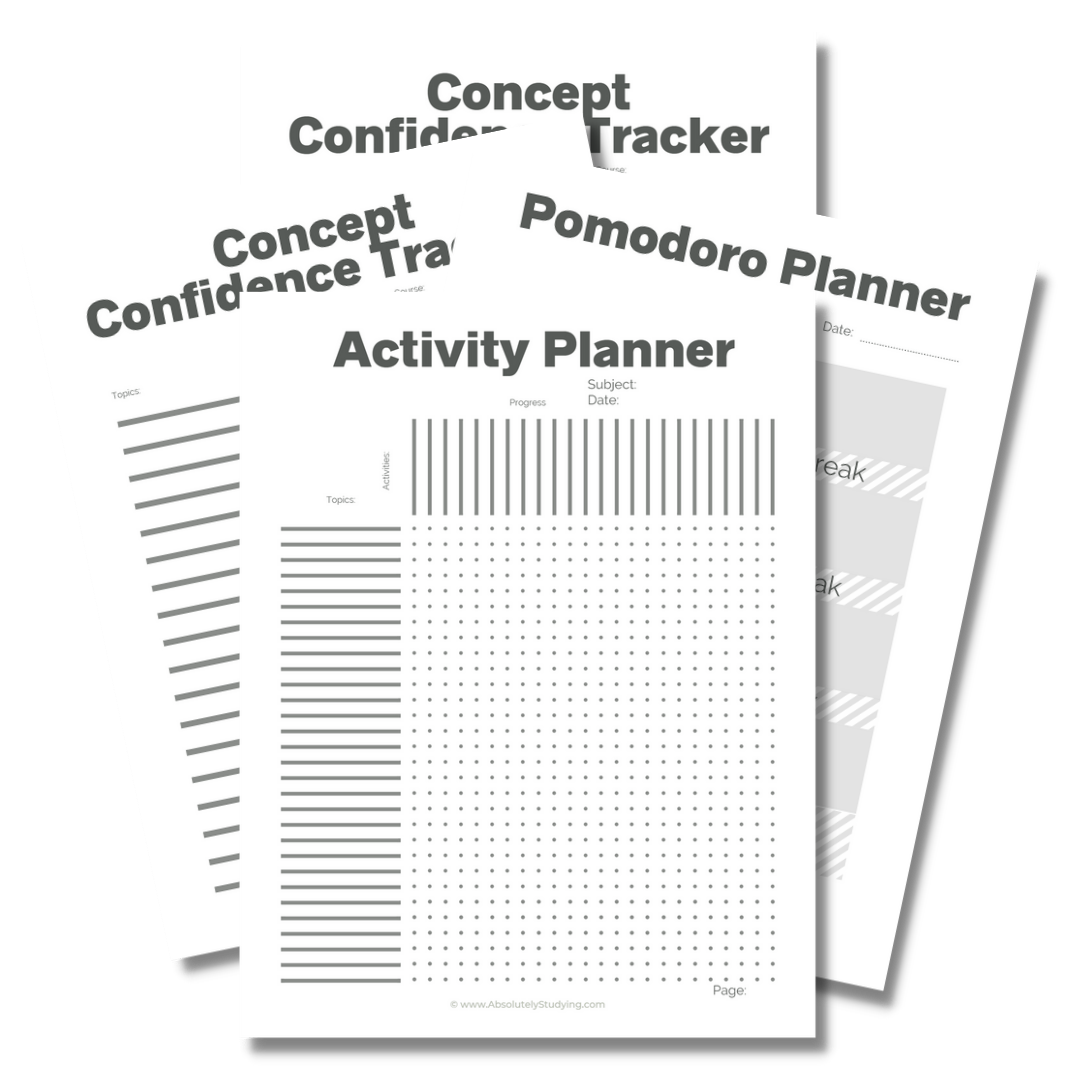How to Create Your Own Note-Taking Shorthand
How to Create Your Own Note-Taking Shorthand
Learn how writing shorthand notation can help boost your notetaking technique.
Everything you need for the semester you want!
This bundle includes:
The Syllabus Study Planner
The Pomodoro Planner
A Confidence Tracker
A Q&A planner
The “Get Organized Checklist”
and more!
This workbook is full of super useful resources that can be applied to every aspect of your day.
* Disclaimer * Some of the posted links are affiliate programs. By clicking these links, I may receive monetary compensation. This will not alter the price or change the buyer's experience.
One of the most vital skills needed to excel in school, especially at university, has very little time dedicated to preparing for it. There is no class in high school for note-taking. They don’t take you aside when you enroll in college and give you an introductory course in frantically jotting down the word salad coming at you from the professor. They only tell you to get down all the important bits. But what does that even mean?
I’m one of those people who want to know how things work in-depth, so telling me to jot down only what is important seems vague and frustrating. I need more specifics! How can I tell what is important and what’s not? How can I trust my judgment when I haven’t yet learned the material?
What if everything is important? How am I supposed to know what is vital and what’s filler? I have an entire unit of my study skills course dedicated to note-taking strategies. No single method will work for everyone, so this unit leads you to choose the right technique. Today, we will focus on the one thing they all have in common, shorthand.
If you want to get a jump on learning how to write shorthand, pick up my free study guide template. I have included a special note-taking shorthand template to fast-track learning common note-taking abbreviations. Download it here for everything you need for an amazing study strategy!
Study Planner Template
Download your free study guide template. It has everything you need for the grades you want.
Why Shorthand Enhances Note-Taking Efficiency
Professors don’t always slow their natural speech for the lecture. Copying down even a brief summary of points can sometimes cause you to lag behind and miss important concepts. Writing shorthand will help you keep up. A reliable, consistent set of shorthand symbols for note-taking is essential for continued education.
One option that many students fall back on is typing. While typing may seem like a great way to speed up your note-taking, it comes with significant drawbacks. Studies show that handwriting your notes is better for memory than typing them.
Writing your notes by hand has a ton of benefits, but it’s slow. If you don’t get the information down in the first place, it will be hard to study it. That’s why shorthand is so essential. To help you to speed up the pace at which you can record the information.
Even if you try using a backup method, like watching a recording of the lecture, it’s still easier to rewrite notes from another paper source than from a recording. This method is cumbersome, labour-intensive, and a huge time sink.
You have to watch or listen to the recording in its entirety to be able to pull out the important bits. That, coupled with how easy it is to pause and rewind to get the exact wording, you could wind up investing a ton of time into this.
You are forced to focus when you can’t rely on the ability to pause and rewind. You have to pay attention to what is said and work double time to paraphrase and write it down. This leaves little time for your mind to wander.
Recording the lecture also has no guarantees. Often recordings can be muffled, fail, or lost if you don’t have time to reference them immediately. There is no recourse if you rely on these. They are lost. The information is simply gone.
Step-by-Step Guide to Creating Your Shorthand System
Creating shorthand symbols will be a largely personal choice. The trick is to replace common words or phrases with abbreviations. This will speed up your ability to take down information as it is given to you.
Identify Commonly Used Words and Phrases
One of the key elements for developing your own shorthand is consistency. Using the same notation for the exact words or phrases will help you build fluency.
As you get comfortable with your shorthand symbols, it will become easier and easier to both write and read your scribbles. You can use the same note-taking abbreviations and symbols across your classes.
It’s never too late or too early to implement this trick. Start early, and soon, you will be able to incorporate more and more symbols, making your note-taking faster and easier than ever.
Try out several note-taking methods to see what works for you.
The symbols that you choose for your shorthand should come naturally to you. If you consistently struggle to remember one while writing your notes or trying to read them, that symbol might not be the right one for you.
Don’t be afraid to switch out symbols that don’t work for you. Remember, this shorthand is only for you to be able to understand. Use abbreviations and notations that you are comfortable with and that make sense to you.
In the beginning, this might take some experimenting. That’s okay. Try out different things until you are comfortable with your notation.
Don’t worry about making your notes pretty during the lecture. Instead, focus on getting down the information.
Class time is tough. The professor is up there talking about many different concepts, and you struggle to get them all down. The purpose of shorthand is to speed up the writing process. You have to make sure to catch all of this information. The last thing you need to worry about is the aesthetics of your notebook.
Lecture notes are messy. They will often look like scribbles, and there is little you can do about it. Use this time to focus on the new information and record it. Later, during your study time, you can make it look pretty.
Study Skills Digital Course
Learn how to create a stress-free, comprehensive strategy!
Keep your shorthand simple.
While journalists use a shorthand that could be considered a completely different language, yours does not have to be that complicated. The most important thing is that:
it makes sense to you,
it’s quicker than the original word or phrase,
and that you will remember its meaning outside of the context.
Develop a dependable shorthand system that you can use across your college or university career. This will save you a ton of time and frustration.
Unlocking Academic Excellence with the Manifesting Good Grades Workbook
While mastering the art of shorthand and elevating my note-taking game, I created a secret weapon that transformed my study sessions and, ultimately, my grades. It's something I wholeheartedly believe every student should have in their arsenal: the Manifesting Good Grades Workbook. Imagine a tool so potent that it not only complements your newly honed shorthand skills but amplifies them, guiding you to harness the power of focused intention and strategic action to manifest the academic success you've always envisioned.
This isn't just another workbook; it's a journey—a step-by-step guide designed to align your study efforts with your highest aspirations. The workbook is your personal blueprint, meticulously crafted to help you visualize and achieve the grades you desire. It's the companion I wish I had when I started my own academic adventures, packed with insights, strategies, and exercises tailored to elevate your learning experience and outcomes.
Whether you're deciphering the complexities of calculus or exploring the depths of history, the Manifesting Good Grades Workbook offers a structured approach to setting goals, understanding content, and reflecting on progress. It's more than just a study aid; it's a manifesto for academic empowerment, encouraging you to take charge of your educational journey with confidence and clarity.
So, if you're ready to transform your potential into palpable success, to not just dream about top-tier grades but actually achieve them, I invite you to embrace this tool. Dive into the Manifesting Good Grades Workbook and discover how your academic dreams can become your reality. It's time to turn your hard work into stellar results. Start your journey to academic excellence here.
At first, it seems like a big hassle to develop a whole new method of writing. But with practice comes fluency. This is a muscle you will exercise for the entire duration of your studies. The fumbling you have in your first few weeks will greatly ease over the years of your academics.
As you get used to writing shorthand, it will become second nature. This way, you can spend less time worrying about how to get down all this new information and more time thinking critically about the concepts.
If you are ready to incorporate shorthand into your note-taking strategies, pick up my study guide template. There is a full page of shorthand symbols that you can start using right away. Try these out or use them as inspiration to create your own. Download it here.
I would like to be transparent so that there are no misunderstandings. As an affiliate, I may earn a small commission from any products linked in this post. This is not a sponsored post, and I was not asked to recommend these products. These are products that I genuinely love and want to share with my audience.






